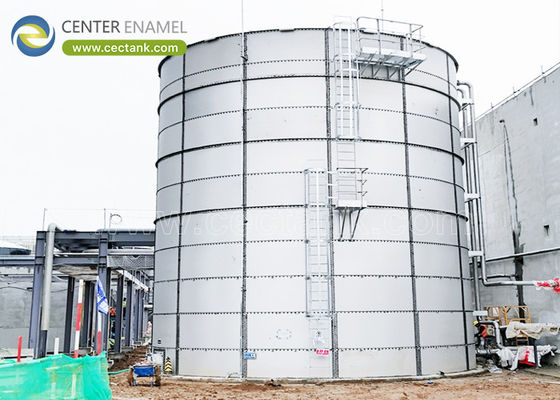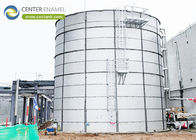-
Glass Fused Steel Tanks (248)
-
Stainless Steel Bolted Tanks (148)
-
Fusion Bonded Epoxy Tanks (68)
-
Galvanized Steel Tanks (44)
-
Aluminum Dome Roofs (82)
-
Waste Water Storage Tanks (218)
-
Anaerobic Digester Tank (203)
-
Industrial Water Tanks (178)
-
Glass Lined Water Storage Tanks (181)
-
Bolted Steel Tanks (167)
-
Sludge Storage Tank (118)
-
Biogas Storage Tank (163)
-
Liquid Storage Tanks (173)
-
Leachate Storage Tanks (140)
-
Agricultural Water Storage Tanks (175)
-
Fire Water Tank (168)
-
Grain Storage Silos (119)
-
Biogas Plant Project (43)
-
Wastewater Treatment Projects (98)
Enhancing Biogas Production And Sustainability With Stainless Steel Tanks
| Place of Origin: | China |
| Brand Name: | CEC TANKS |
| Certification: | ISO 9001:2008, AWWA D103 , OSHA , BSCI |
| Model Number: | W |
| Minimum Order Quantity: | 1set |
| Price: | $5000~$20000 one set |
| Packaging Details: | PE poly-foam between each two steel plates ; wooden pallet and wooden |
| Delivery Time: | 10-30 days after deposit received |
| Payment Terms: | L/C, T/T |
| Supply Ability: | 60 sets per month |
|
Detail Information |
|||
| Place of Origin | China | Brand Name | CEC TANKS |
|---|---|---|---|
| Certification | ISO 9001:2008, AWWA D103 , OSHA , BSCI | Model Number | W |
| Corrosion Resistance: | Suitable For Waste Water Salt Water, Sea Water, High Sulfur Crude Oil, Salt Fox, Organic And Inorganic Compounds | Elastic: | Same As Steel Sheet ,around 500KN /mm |
| Tank Body Color: | Customized Design | Coating Thickness: | No |
| Foundation: | Concrete | Steel Grade: | Stainless Steel |
| High Light: | Enhancing Biogas Production Stainless Steel Tanks,Sustainability Stainless Steel Tanks |
||
Product Description
In the realm of renewable energy and sustainable practices, biogas production stands out as a versatile and eco-friendly solution. Central to the efficiency and durability of biogas systems are the tanks used for storing and processing biogas. Among the various options available, stainless steel tanks emerge as a top choice due to their exceptional qualities and benefits. This article explores the role of stainless steel tanks in biogas production, highlighting their impact on system performance, longevity, and environmental sustainability.
The Advantages of Stainless Steel Tanks in Biogas Production
1. Corrosion Resistance:
Stainless steel tanks are highly resistant to corrosion, making them ideal for storing biogas, which can contain corrosive elements. This resistance ensures long-term durability and reliability of the tanks, minimizing maintenance costs and downtime.
2. Strength and Durability:
The inherent strength of stainless steel ensures that the tanks can withstand the pressure and stresses associated with biogas storage and processing. This durability translates to a longer lifespan for the tanks, contributing to overall system sustainability.
3. Gas-Tight Seal:
Stainless steel tanks can be designed with precise sealing mechanisms, ensuring a gas-tight seal essential for preventing gas leaks and maintaining the integrity of the biogas production process. This feature enhances safety and efficiency in biogas operations.
4. Easy Maintenance:
The smooth surface of stainless steel makes it easy to clean and maintain, reducing the risk of contamination and ensuring optimal performance of the biogas system over time. Routine maintenance tasks are simplified, enhancing operational efficiency.
5. Environmental Benefits:
Using stainless steel tanks aligns with environmental goals as stainless steel is recyclable and has a low environmental impact during production. This supports the sustainability objectives of biogas projects, contributing to a greener energy landscape.
Application of Stainless Steel Tanks in Biogas Systems
1. Biogas Storage:
Stainless steel tanks serve as reliable storage units for biogas generated from organic waste materials. Their gas-tight properties ensure efficient storage without gas losses, maximizing the utilization of biogas for energy production.
2. Digestate Processing:
In biogas plants, digestate is a byproduct that requires processing. Stainless steel tanks are used for digestate storage and treatment, maintaining hygienic conditions and facilitating the conversion of digestate into valuable organic fertilizers.
3. System Expansion and Upgrades:
Stainless steel tanks offer flexibility for system expansion and upgrades due to their modular design and compatibility with various biogas system components. This adaptability supports scalability and future-proofing of biogas facilities.
Installation and Maintenance Best Practices
1. Professional Installation:
It's crucial to have stainless steel tanks installed by experienced professionals to ensure proper assembly, sealing, and integration into the biogas system. This minimizes the risk of operational issues and maximizes tank performance.
2. Regular Inspections:
Implementing regular inspections of stainless steel tanks helps detect any potential issues early, allowing for timely maintenance and repairs. This proactive approach enhances the longevity and reliability of the tanks in biogas applications.
3. Cleaning and Maintenance Protocols:
Follow manufacturer-recommended cleaning and maintenance protocols to preserve the integrity of stainless steel tanks. Routine cleaning, corrosion prevention measures, and inspection of seals and fittings are essential for optimal tank performance.
Stainless steel tanks play a crucial role in enhancing biogas production efficiency, sustainability, and reliability. Their corrosion resistance, strength, gas-tight sealing, and environmental benefits make them a preferred choice for biogas storage, digestate processing, and system expansion. By adhering to best practices in installation, maintenance, and operation, biogas projects can leverage the advantages of stainless steel tanks to contribute significantly to a greener and more sustainable energy future.
Installation Steps for Stainless Steel Tanks
The installation process of stainless steel tanks can be divided into stages, including site preparation, assembly of enamel-coated steel plates, and tank erection. Below are detailed installation steps:
The installation process of stainless steel tanks involves several key steps, and the following is a detailed explanation of the installation process based on the provided content:
Step 1: Clean and prepare the installation site, ensuring the surface is level and clean to provide a good construction condition.
Step 2: Construct a sturdy foundation using sand or crushed stones, and lay concrete walls or a full concrete slab on the foundation to ensure a stable base.
Step 3: Start from the bottom of the structure, progressively install the individual panels of the stainless steel tank according to the design drawings or installation guidelines.
Step 4: Ensure cleanliness and dryness when applying adhesive to the steel plates; replace bolts and nuts if there is any sign of bolt detachment during the installation process.
Step 5: After completing the assembly of the bottom layer, use reinforcing bars to securely connect the bottom layer to the foundation to increase overall stability.
Step 6: Assemble the second layer and use a lifting machine to connect it to the bottom layer. Continue layer-by-layer assembly of the stainless steel tank, ensuring a tight connection between each layer and the bottom layer.
Step 7: Install anti-wind beams or support structures at the connection points between two layers to ensure sufficient overall stability of the tank, especially when facing external forces such as wind.
Step 8: Add valves, doors, or manhole covers, etc., as needed, and in appropriate locations, to meet the functional and usage requirements of the stainless steel tank.
Step 9: Finally, install the tank top, ensuring the sealing integrity of the tank after all panels are installed.
By following these steps, stainless steel tanks can be safely and stably assembled, ensuring the quality of adhesion and connections, and providing a high-quality, durable tank system.
As a leading player in the Asian enamel-assembled tank industry, and a high-quality service provider in environmental EPC and anaerobic process segments, Zhong Technology has been committed to the innovation and development of the environmental industry. Continuously exploring innovative water treatment solutions, the company leads the high-quality development of the water treatment sector. Years of innovative development have equipped the company with leading technologies and rich experience in the water treatment field, providing global customers with professional and reliable solutions according to international standards, earning trust and acclaim from clients.
From south to north, from east to west, from domestic to international, Zhong Technology projects now span 90 countries globally. Zhong Technology will continue to leverage its core advantages in technology, equipment, and services to provide customers with more advanced and reliable water treatment solutions. The company will also strengthen cooperation with domestic and international partners, continuously driving innovation and application of water treatment technologies.




